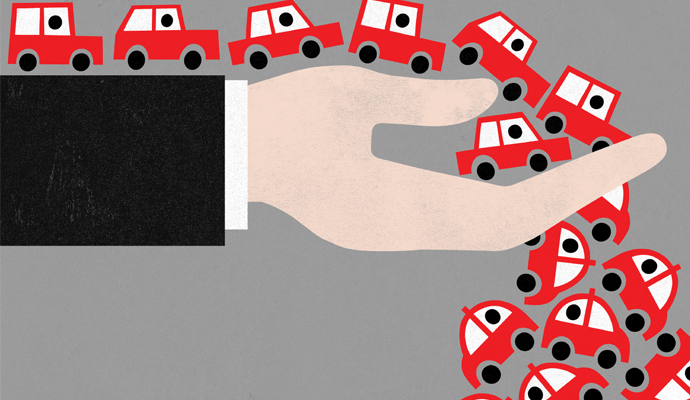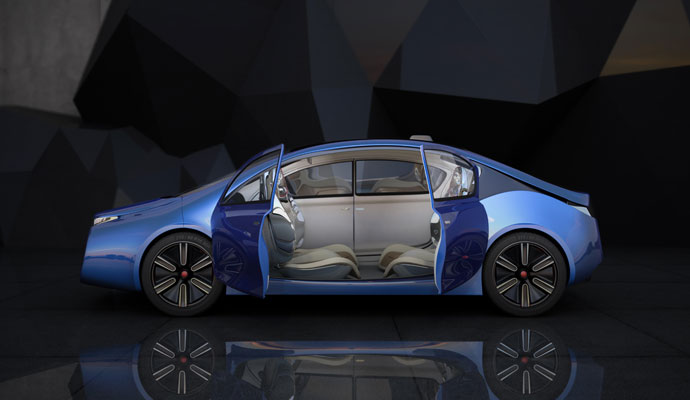Who Will Insure Self-Driving Cars?
The advent of autonomous vehicles may send the auto insurance industry over a cliff.
A version of this article appeared in the Spring 2017 issue of strategy+business.
If you are an executive of an auto insurance company, pay attention — you may not have a business in 20 years. You can blame the fundamental shifts in auto safety and data mining that connected car and autonomous vehicle technologies will bring. Robot drivers will outnumber humans behind the wheel. The remaining human drivers will be safer, thanks to collision-preventing sensors and analytics on board. Insurance claims will be rare, losses will be reduced, premiums will decline, and insurance companies will probably lose control of the data that makes their pricing models possible. Car owners might no longer purchase insurance directly. Instead, automakers would bundle insurance into each new car purchase, much as they do satellite radio and roadside service contracts today.
These types of structural business model changes don’t happen often, especially in a regulated sector like auto insurance. And although the shift isn’t imminent, it is practically inevitable. Already, driverless cars have moved from low-speed and test environments to limited use on public roads and highways. Safety and production issues need to be addressed before widespread adoption can occur, but the auto industry and the businesses that support it are pushing hard for change.
Global auto insurance is a US$700 billion market (pdf) that represents 42 percent of global aggregate property and casualty insurance, according to Swiss Re. It is an extremely competitive market today, and it will be still more competitive by 2030. Research conducted by our DeNovo strategy consulting platform suggests that auto insurance companies will find themselves squeezed out of conventional auto insurance altogether. They would then have to find new sources of revenue: expanding into non-automotive fields such as commercial liability and cybersecurity coverage or, perhaps, partnering with car manufacturers and ride-sharing services.
If you’re in this sector, you may feel that you have a long time to prepare. Data from the Insurance Institute for Highway Safety suggests that mass-market (95 percent) adoption of vehicle safety features takes approximately 30 years. Such features are typically introduced in luxury vehicles and then, as costs fall, expand across the entire fleet. But insurers do not usually wait for full adoption before adjusting rates. Front airbags, for example, were introduced in 1984, have been mandatory on all new U.S. passenger vehicles since 1998, and only in 2016 were they installed in 95 percent of the national fleet. Yet auto insurance premium reductions of 25 to 40 percent for cars with airbags were phased in long ago. The addition of airbags now saves roughly 2,500 lives per year in the U.S., according to the National Highway Traffic Safety Administration (NHTSA), and this has directly influenced actuarial assumptions.
Insurance will likely be bundled into new car purchases, like satellite radio and roadside service contracts.
The overall safety improvements ushered in by self-driving technology will similarly affect insurance risk models before fully autonomous vehicles reach the mainstream. Safety is expected to improve rapidly. The first accident initiated by a Google autonomous car occurred after 1.45 million vehicle miles traveled (VMT) (pdf), which is approximately 0.7 accidents per million VMT. This is significantly lower than the current U.S. average of about 2.0 accidents per million VMT. Given that human error is responsible for more than 90 percent of all accidents in the U.S., insurers will be pressured to shave premiums.
How rapidly will autonomous vehicles advance? Much depends on regulation. Current regulations are friendlier to autonomous vehicles than one might expect, given how many technical challenges are still to be solved. For example, the recently announced U.S. driverless vehicle policy does not contain specific regulations but rather guidance for safety measures and for how these vehicles can conform to local and federal traffic rules. The intention of this policy’s flexibility is to avoid the lengthy process usually associated with developing standards for new auto technologies. The fact that autonomous vehicles may bring transportation to millions of disabled Americans also may spur regulatory approval. Further, regulators are aware that in the small number of incidents involving autonomous vehicles to date, human error was to blame most of the time.
Another major factor in the development of self-driving vehicles is price. According to a 2014 IHS Markit report, the incremental cost to the consumer of autonomous driving technology will be $7,000 to $10,000 per vehicle in 2025. This suggests that autonomous vehicles could command a luxury premium for the foreseeable future.
But mainstream manufacturers are working steadily toward incorporating this technology into mass-market autos. General Motors (GM) may prove to be the front-runner; it began testing its autonomous Chevy Bolt in August 2016. Ford has stated its intention to deliver fully autonomous vehicles in high volume by 2021. Toyota has invested $1 billion in a new research institute to develop a self-driving concept car. Projected to appear in 2020, it will assist drivers rather than replacing them. With all the research and development activity under way, we expect the first autonomous vehicle insurance policies to be written by 2019.
Reinventing Auto Insurance
If even a small number of autonomous vehicles replace those driven by humans, the revenue from insurance premiums will decline, and the sector’s business models will lose ground. Auto insurers could face structural changes in their underwriting and risk modeling, as well as revisions to the underlying components of policies.
The greatest risk for insurers is losing control over the data on which they depend to price risk effectively. Data including statistics on speed, distance between vehicles, response to weather conditions, brake pressure, and driver distractions will be gathered by software embedded in the car that is proprietary to the manufacturer. Automakers will aggregate that data from a vast fleet of connected vehicles. They will thus be in a better position than insurers to understand and price risk. This shift creates the potential for a battle over data ownership.
Will automakers sell cars and insurance as a package deal? It’s possible. They have developed new revenue streams before. For example, the General Motors Acceptance Corporation, now known as Ally Financial, was founded in 1919 to give GM’s dealers access to financing.
To expand into insurance, vehicle manufacturers would need to obtain necessary state licenses by acquiring insurance companies or seeking these licenses themselves. Some autonomous vehicle manufacturers are showing signs of interest in this path. For instance, Tesla has introduced InsureMyTesla, a service in Hong Kong and Australia that works with AXA General Insurance and QBE Insurance, respectively, to offer insurance policies tailored to its customers. Tesla will not conduct the underwriting or retain the risk, but the automaker will learn the claims and customer service aspects of the insurance process.
Meanwhile, the growing prevalence of software controls will change the dynamics of auto repair after crashes. Insurers will need to rethink how they value the replacement costs for damaged vehicles. Software has high development costs, but low-to-negligible costs for distribution (for example, through software updates). This gives manufacturers an inherent advantage in valuing the replacement cost, and a more compelling rationale to enter the insurance market, because low replacement and distribution costs increase the likelihood that bundling insurance will be profitable.
The Insurers’ Response
The many unknowns will affect the way the insurance business evolves. For example, autonomous technology is already ahead of consumer acceptance. Many people are not yet mentally prepared to embrace these cars in every aspect of everyday life: for example, as a way for young children to travel unaccompanied by an adult. Further, the practice of evaluating autonomous vehicle safety is still in its infancy. Even if statistics demonstrate that autonomous driving is safe, it is not clear how the industry or regulators will assign fault in the collisions that do occur.
Consider, for example, the widely reported May 2016 fatality in which a self-driven Tesla car hit a truck that was making a left turn. There was a human driver in the car, who apparently had put the car in autopilot mode. The NHTSA announced in January that it would require no recall. It did not attribute the accident to defects in the car, but it implied that future autonomous vehicles might be limited to roadways designed for them. The decision could have broad implications for how autonomous vehicles are insured and how insurers design personal auto policies. New policies may explicitly exclude certain autonomous driving activities and may require an additional rider or add-on provision.
Typical personal auto policies do not specify which features the insured chooses to purchase or use while driving. In the future, insurers will not necessarily be aware of the various autonomous driving features on individual vehicle models or how they can be activated. Thus, either policies will need to evolve to match broad groups of features or there will need to be an unprecedented degree of fine-grained cooperation between insurers and manufacturers.
Autonomous vehicles’ reliance on software may open the way for multitiered insurance products. For example, insurers could offer a hybrid product combining commercial liability with specific cybersecurity protection and personal auto insurance.
Cyber risk is a real concern for autonomous vehicles, and will need to be priced into insurance policies. In 2015, Chrysler voluntarily recalled 1.4 million vehicles because of a software flaw that could allow the vehicles to be remotely accessed. In September 2016, Tesla updated its software in response to a breach that permitted remote access to and control of functions, including turn signals and the braking system.
U.S. government security and safety agencies have sounded the alarm, too. The FBI, the Department of Transportation, and the NHTSA issued a joint public service announcement in March 2016 warning that driverless vehicles are increasingly at risk for unauthorized remote access intended to obtain driver data or manipulate vehicle functionality.
Nonetheless, the die is cast in favor of autonomous vehicle technology. Production of 12.4 million connected cars is forecast in 2016, and annual growth of 49 percent is expected through 2020, according to the Gartner Group. The business models of both automakers and insurance companies, therefore, will need to adjust, and adjust quickly.
For insurers, the winners will be those that move early to respond to the drop in revenues from traditional auto premiums and that identify new opportunities (such as coverage of cybersecurity in cars) where risk is not yet well understood and where new forms of insurance will be in demand.
Reprint No. 17104
Author profiles:
- Chris Martin is the insurance industry specialist for DeNovo, a next-generation strategy consulting platform focused on fintech innovation.
- Aaron Schwartz is the head of research for DeNovo. He is a director with PwC US.
- Haskell Garfinkel is the co-leader of PwC’s fintech practice and a founder of DeNovo. He is a partner with PwC US.
- DeNovo is published by PwC under Strategy&, the strategy consulting business at PwC. For more information, see strategyand.pwc.com/denovo.





